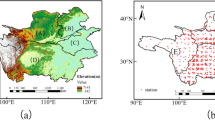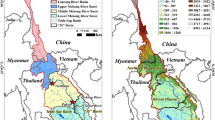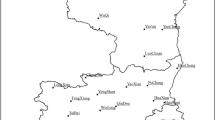Abstract
Gauge-measured precipitation (Pm) is prone to negative bias; therefore, using corrected gauge-measured precipitation (Pc) is critical in climate and hydrology studies, although it is utilized insufficiently in existing research. This study uses Pm and Pc to establish extreme precipitation indices (EPIs) and compares the differences in their evolution characteristics and their responses to large-scale circulation indices (LSCIs). Theil’s slope and the modified Mann–Kendall test are used to identify the evolution characteristics of EPIs. Probabilistic condition selection and momentary conditional independence and the Liang-Kleeman information flow are adopted to evaluate the causal relationship between the EPIs and LSCIs. The main results are as follows: (1) The magnitude, intensity, and frequency of the Pc-based EPIs are higher than those of the Pm-based EPIs in China, except for the consecutive dry days (CDD). This result suggests that previous estimates of Pm-based EPIs underestimated the magnitude, intensity, and frequency at most stations, especially in the Southwestern River where droughts and flood areas may have been underestimated. Thus, the frequency of Southwestern River droughts and floods and their sudden transitions may be higher. (2) The slope increases in the Pc-based EPIs (except for the Southwestern River), and their significance levels are lower than those of the Pm-based EPIs. Conversely, the slope decreases in the Pc-based EPIs (except for the Southwestern River), and their significance levels (except for the Songliao River) are higher than those of the Pm-based EPIs. The internal variability of the climate system and the external forcing in some basins are the reasons for the significantly increasing slopes of very wet days (R95p), simple daily intensity index (SDII), and extremely wet days (R99p). However, the significant decreasing slopes are attributed to internal climate variability. (3) Unlike the Pm-based EPIs, the Pc-based EPIs did not alter the causal relationship with LSCIs, indicating that Pc did not change the causal relationship with LSCIs. The trend, magnitude, intensity, and frequency differ for Pc and Pm. Therefore, Pc and Pm data should be used cautiously in meteorological, hydrological, ecological, environmental, and agricultural simulations in future research.









Similar content being viewed by others
References
Allerup P, Madsen H, Vejen F (1997) A comprehensive model for correcting point precipitation. Hydrol Res 28:1–20. https://doi.org/10.2166/nh.1997.0001
An N, Zuo Z (2021) Changing structures of summertime heatwaves over China during 1961–2017. Sci China Earth Sci 64:1242–1253. https://doi.org/10.1007/s11430-020-9776-3
Arias P, Bellouin N, Coppola E et al (2021) Climate change 2021: the physical science basis. Contribution of Working Group I to the Sixth Assessment Report of the Intergovernmental Panel on Climate Change; Technical Summary
Bao J, Sherwood SC, Alexander LV, Evans JP (2017) Future increases in extreme precipitation exceed observed scaling rates. Nat Clim Chang 7(2):128–132. https://doi.org/10.1038/NCLIMATE3201
Boers N, Goswami B, Rheinwalt A et al (2019) Complex networks reveal global pattern of extreme-rainfall teleconnections. Nature 566:373–377. https://doi.org/10.1038/s41586-018-0872-x
Chen Y, Li Y (2017) An inter-comparison of three heat wave types in China during 1961–2010: observed basic features and linear trends. Sci Rep 7:45619. https://doi.org/10.1038/srep45619
Chen X, Wang S, Hu Z et al (2018) Spatiotemporal characteristics of seasonal precipitation and their relationships with ENSO in Central Asia during 1901–2013. J Geogr Sci 28:1341–1368. https://doi.org/10.1007/s11442-018-1529-2
Cheng Q, Jin H, Ren Y (2023) Compound daytime and nighttime heatwaves for air and surface temperature based on relative and absolute threshold dynamic classified in Southwest China, 1980–2019. Sustain Cities Soc 91:104433. https://doi.org/10.1016/j.scs.2023.104433
Cherenkova EA, Semenov VA (2017) A link between winter precipitation in Europe and the Arctic Sea ice, sea surface temperature, and atmospheric circulation. Russ Meteorol Hydrol 42:238–247. https://doi.org/10.3103/S1068373917040045
Deng Y, Jiang W, He B et al (2018) Change in intensity and frequency of extreme precipitation and its possible teleconnection with large-scale climate index over the China from 1960 to 2015. J Geophys Res Atmos 123:2068–2081. https://doi.org/10.1002/2017JD027078
Ding Y, Yang D, Ye B, Wang N (2007) Effects of bias correction on precipitation trend over China. J Geophys Res Atmos 112. https://doi.org/10.1029/2006JD007938
Donat MG, Alexander LV, Yang H et al (2013a) Updated analyses of temperature and precipitation extreme indices since the beginning of the twentieth century: The HadEX2 dataset. J Geophys Res Atmos 118:2098–2118. https://doi.org/10.1002/jgrd.50150
Donat MG, Alexander LV, Yang H et al (2013b) Global land-based datasets for monitoring climatic extremes. Bull Am Meteorol Soc 94:997–1006. https://doi.org/10.1175/BAMS-D-12-00109.1
Donat MG, Lowry AL, Alexander LV et al (2016) More extreme precipitation in the world’s dry and wet regions. Nat Clim Change 6:508–513. https://doi.org/10.1038/nclimate2941
Dutta R, Maity R (2018) Temporal evolution of hydroclimatic teleconnection and a time-varying model for long-lead prediction of Indian summer monsoon rainfall. Sci Rep 8:10778. https://doi.org/10.1038/s41598-018-28972-z
Fekete A, Sandholz S (2021) Here comes the flood, but not failure? Lessons to learn after the heavy rain and pluvial floods in Germany 2021. Water 13:3016. https://doi.org/10.3390/w13213016
Fischer E, Knutti R (2015) Anthropogenic contribution to global occurrence of heavy-precipitation and high-temperature extremes. Nature Clim Change 5(6):560–564. https://doi.org/10.1038/nclimate2617
Fischer EM, Sippel S, Knutti R (2021) Increasing probability of record-shattering climate extremes. Nat Clim Chang 11(8):689–695. https://doi.org/10.1038/s41558-021-01092-9
Fu S, Zhang H, Zhong Q et al (2023) Spatiotemporal variations of precipitation concentration influenced by large-scale climatic factors and potential links to flood-drought events across China 1958–2019. Atmospheric Res 282:106507. https://doi.org/10.1016/j.atmosres.2022.106507
Gao J, Shao C, Chen S, Zhang X (2021) Spatiotemporal evolution of sustainable development of China’s provinces: a modelling approach. Ecosyst Health Sustain 7:1965034. https://doi.org/10.1080/20964129.2021.1965034
Goodison BE, Louie PY, Yang D (1998) WMO solid precipitation measurement intercomparison: Final report. WMO Tech Doc 872:212
Groisman PY, Koknaeva VV, Belokrylova TA, Karl TR (1991) Overcoming biases of precipitation measurement: a history of the USSR experience. Bull Am Meteorol Soc 72:1725–1733. https://doi.org/10.1175/1520-0477(1991)072<1725:OBOPMA>2.0.CO;2
Gupta V, Jain MK (2021) Unravelling the teleconnections between ENSO and dry/wet conditions over India using nonlinear Granger causality. Atmospheric Res 247:105168. https://doi.org/10.1016/j.atmosres.2020.105168
Jiang R, Wang Y, Xie J, et al (2019) Assessment of extreme precipitation events and their teleconnections to El Niño Southern Oscillation a case study in the Wei River Basin of China. Atmos Res 218:372–384. https://doi.org/10.1016/j.atmosres.2018.12.015
Jiang J, Zhou T, Zhang W (2022) Temporal and spatial variations of extreme precipitation in the main river basins of china in the past 60 years. Chin J Atmos Sci 46:707–724. https://doi.org/10.3878/j.issn.1006-9895.2111.21187
Karl TR, Quayle RG, Groisman PY (1993) Detecting climate variations and change: new challenges for observing and data management systems. J Clim 6:1481–1494. https://doi.org/10.1175/1520-0442(1993)006<1481:DCVACN>2.0.CO;2
Konapala G, Mishra A (2017) Review of complex networks application in hydroclimatic extremes with an implementation to characterize spatio-temporal drought propagation in continental USA. J Hydrol 555:600–620. https://doi.org/10.1016/j.jhydrol.2017.10.033
Legates DR, Willmott CJ (1990) Mean seasonal and spatial variability in gauge-corrected, global precipitation. Int J Climatol 10:111–127. https://doi.org/10.1002/joc.3370100202
Li W, Chen Y (2021) Detectability of the trend in precipitation characteristics over China from 1961 to 2017. Int J Climatol 41:E1980–E1991. https://doi.org/10.1002/joc.6826
Li N, Li Y, Yao N (2018) Bias correction of the observed daily precipitation and re-division of climatic zones in China. Int J Climatol 38:3369–3387. https://doi.org/10.1002/joc.5506
Li Y, Wang K, Wu G, Mao Y (2023) Effects of wind-induced error on the climatology and trends of observed precipitation in China from 1960 to 2018. J Hydrometeorol 24:1055–1067. https://doi.org/10.1175/JHM-D-22-0153.1
Liang X (2014) Unraveling the cause-effect relation between time series. Phys Rev E 90:052150. https://doi.org/10.1103/PhysRevE.90.052150
Liang X, Kleeman R (2005) Information transfer between dynamical system components. Phys Rev Lett 95:244101. https://doi.org/10.1103/PhysRevLett.95.244101
Lu S, Hu Z, Yu H, Fan W, Fu C, Wu D (2021) Changes of extreme precipitation and its associated mechanisms in Northwest China. Adv Atmos Sci 38:1665–1681. https://doi.org/10.1007/s00376-021-0409-3
Luo M, Lau NC (2019) Urban expansion and drying climate in an urban agglomeration of east China. Geophys Res Lett 46:6868–6877. https://doi.org/10.1029/2019GL082736
Madakumbura GD, Thackeray CW, Norris J, Goldenson N, Hall A (2021) Anthropogenic influence on extreme precipitation over global land areas seen in multiple observational datasets. Nat Commun 12(1):3944. https://doi.org/10.1038/s41467-021-24262-x
Mann HB (1945) Nonparametric tests against trend. Econom J Econom Soc 245–259. https://doi.org/10.2307/1907187.
Mondal S, Mishra AK (2021) Complex networks reveal heatwave patterns and propagations over the USA. Geophys Res Lett 48:e2020GL090411. https://doi.org/10.1029/2020GL090411
Murray V, Ebi KL (2012) IPCC special report on managing the risks of extreme events and disasters to advance climate change adaptation (SREX). J Epidemiol Community Health 66:759–760
Papalexiou SM, Montanari A (2019) Global and regional increase of precipitation extremes under global warming. Water Resour Res 55:4901–4914. https://doi.org/10.1029/2018WR024067
Pettitt AN (1979) A non-parametric approach to the change-point problem. J R Stat Soc Ser C Appl Stat 28:126–135. https://doi.org/10.2307/2346729
Pfahl S, O’Gorman PA, Fischer EM (2017) Understanding the regional pattern of projected future changes in extreme precipitation. Nat Clim Change 7:423–427. https://doi.org/10.1038/nclimate3287
Runge J, Bathiany S, Bollt E et al (2019a) Inferring causation from time series in Earth system sciences. Nat Commun 10:2553. https://doi.org/10.1038/s41467-019-10105-3
Runge J, Nowack P, Kretschmer M, Flaxman S, Sejdinovic D (2019b) Detecting and quantifying causal associations in large nonlinear time series datasets. Sci Adv 5(11):eaau4996. https://doi.org/10.1126/sciadv.aau4996
Runge J, Gerhardus A, Varando G, Eyring V, Camps-Valls G (2023) Causal inference for time series. Nat Rev Earth Environ 4(7):487–505. https://doi.org/10.1038/s43017-023-00431-y
Sen PK (1968) Estimates of the regression coefficient based on Kendall’s tau. J Am Stat Assoc 63:1379–1389. https://doi.org/10.1080/01621459.1968.10480934
Sun JQ, Ao J (2013) Changes in precipitation and extreme precipitation in a warming environment in China. Chin Sci Bull 58 (12):1395–1401. https://doi.org/10.1007/s11434-012-5542-z
Sun Q, Zhang X, Zwiers F, Westra S, Alexander LV (2021) A global, continental, and regional analysis of changes in extreme precipitation. J Clim 34(1):243–258. https://doi.org/10.1175/JCLI-D-19-0892.1
Tan X, Gan TY, Shao D (2016) Wavelet analysis of precipitation extremes over Canadian ecoregions and teleconnections to large-scale climate anomalies. J Geophys Res Atmos 121:14–469. https://doi.org/10.1002/2016JD025533
Thackeray CW, Hall A, Norris J, Chen D (2022) Constraining the increased frequency of global precipitation extremes under warming. Nat Clim Chang 12(5):441–448. https://doi.org/10.1038/s41558-022-01329-1
Theil H (1950) A rank-invariant method of linear and polynomial regression analysis. Indag Math 12:173
Ullah W, Wang G, Lou D et al (2021) Large-scale atmospheric circulation patterns associated with extreme monsoon precipitation in Pakistan during 1981–2018. Atmos Res 253:105489. https://doi.org/10.1016/j.atmosres.2021.105489
Von Storch H, Zwiers FW (2002) Statistical analysis in climate research. Cambridge University Press
Wang F, Harindintwali JD, Wei K, et al (2023) Climate change: Strategies for mitigation and adaptation. Innov Geosci 1(1):100015–10. https://doi.org/10.59717/j.xinn-geo.2023.100015
Westra S, Alexander LV, Zwiers FW (2013) Global increasing trends in annual maximum daily precipitation. J Clim 26:3904–3918. https://doi.org/10.1175/JCLI-D-12-00502.1
Wu H, Li X, Schumann GJ-P et al (2021) From China’s heavy precipitation in 2020 to a “Glocal” hydrometeorological solution for flood risk prediction. Adv Atmos Sci 38:1–7. https://doi.org/10.1007/s00376-020-0260-y
Wu Q, Zuo Q, Li D et al (2023) Integrated assessment of multiple characteristics for extreme climatic events under climate change: application of a distribution-evolution-attribution-risk framework. Atmospheric Res 282:106515. https://doi.org/10.1016/j.atmosres.2022.106515
Xi Y, Miao C, Wu J et al (2018) Spatiotemporal changes in extreme temperature and precipitation events in the Three-Rivers Headwater Region, China. J Geophys Res Atmos 123:5827–5844. https://doi.org/10.1029/2017JD028226
Yang D (1987) A case study of the wetting loss experiments in the rain gauge. Meteorol Mon 13:16–18
Yang D, Ohata T (2001) A bias-corrected Siberian regional precipitation climatology. J Hydrometeorol 2:122–139. https://doi.org/10.1175/1525-7541(2001)002<0122:ABCSRP>2.0.CO;2
Yang DQ, Shi YF, Kang ES, Zhang YS, Yang XY (1991) Results of solid precipitation measurement intercomparison in the alpine area of Urumqi river basin. Chin Sci Bull 36(13):1105–1105. https://doi.org/10.1021/cen-v070n044.p004
Yang D, Goodison BE, Metcalfe JR et al (1995) Accuracy of Tretyakov precipitation gauge: result of WMO intercomparison. Hydrol Process 9:877–895. https://doi.org/10.1002/hyp.3360090805
Yang D, Goodison BE, Metcalfe JR et al (1998) Accuracy of NWS 8” standard nonrecording precipitation gauge: results and application of WMO intercomparison. J Atmospheric Ocean Technol 15:54–68. https://doi.org/10.1175/1520-0426(1998)015<0054:AONSNP>2.0.CO;2
Yang D, Elomaa E, Tuominen A et al (1999) Wind-induced precipitation undercatch of the Hellmann gauges. Hydrol Res 30:57–80. https://doi.org/10.2166/nh.1999.0004
Yang D, Goodison B, Metcalfe J et al (2001) Compatibility evaluation of national precipitation gage measurements. J Geophys Res Atmos 106:1481–1491. https://doi.org/10.1029/2000JD900612
Yang D, Kane D, Zhang Z et al (2005) Bias corrections of long-term (1973–2004) daily precipitation data over the northern regions. Geophys Res Lett 32. https://doi.org/10.1029/2005GL024057
Yang R-M, Zhang G-L, Liu F et al (2016) Comparison of boosted regression tree and random forest models for mapping topsoil organic carbon concentration in an alpine ecosystem. Ecol Indic 60:870–878. https://doi.org/10.1016/j.ecolind.2015.08.036
Yang Y, Gan TY, Tan X (2019) Spatiotemporal changes in precipitation extremes over Canada and their teleconnections to large-scale climate patterns. J Hydrometeorol 20:275–296. https://doi.org/10.1175/JHM-D-18-0004.1
Yao N, Li Y, Li N et al (2018) Bias correction of precipitation data and its effects on aridity and drought assessment in China over 1961–2015. Sci Total Environ 639:1015–1027. https://doi.org/10.1016/j.scitotenv.2018.05.243
Ye B, Yang D, Ding Y et al (2004) A bias-corrected precipitation climatology for China. J Hydrometeorol 5:1147–1160. https://doi.org/10.1175/JHM-366.1
Yin L, Ping F, Mao J, et al (2023) Analysis on precipitation efficiency of the “21.7” henan extremely heavy rainfall event. Adv Atmos Sci 40:374–392 . https://doi.org/10.1007/s00376-022-2054-x
Zhang L, Ameca EI, Cowlishaw G, Pettorelli N, Foden W, Mace GM (2019a) Global assessment of primate vulnerability to extreme climatic events. Nat Clim Chang 9(7):554–561. https://doi.org/10.1038/s41558-019-0508-7
Zhang Y, Ren Y, Ren G, Wang G (2019b) Bias correction of gauge data and its effect on precipitation climatology over mainland China. J Appl Meteorol Climatol 58:2177–2196. https://doi.org/10.1175/JAMC-D-19-0049.1
Zhang Y, Ren Y, Ren G, Wang G (2020) Precipitation trends over mainland China from 1961–2016 after removal of measurement biases. J Geophys Res Atmos 125:e2019JD031728. https://doi.org/10.1029/2019JD031728
Acknowledgements
We would like to express our gratitude to the China Meteorological Administration (CMA) for providing the meteorological data.
Funding
This study was supported by the supported by Yunnan Fundamental Research Projects (Grant No. 202301BD070001-093, 202301AT070227, 202201AU70064), Southwest Forestry University Campus level Launch Fund (01102/112105).
Author information
Authors and Affiliations
Contributions
Qingping Cheng: Conceptualization. Qingping Cheng and Hanyu Jin: Formal analysis, Data curation. Qingping Cheng and Hanyu Jin: Methodology, Validation. Qingping Cheng: Writing–original draft preparation, Funding acquisition. Qingping Cheng and Hanyu Jin: Writing—review and editing.
Corresponding author
Ethics declarations
Ethics approval
Not applicable.
Consent to participate
Not applicable.
Consent for publication
Not applicable.
Competing interests
The authors declare no competing interests.
Additional information
Publisher's Note
Springer Nature remains neutral with regard to jurisdictional claims in published maps and institutional affiliations.
Supplementary Information
Below is the link to the electronic supplementary material.
Rights and permissions
Springer Nature or its licensor (e.g. a society or other partner) holds exclusive rights to this article under a publishing agreement with the author(s) or other rightsholder(s); author self-archiving of the accepted manuscript version of this article is solely governed by the terms of such publishing agreement and applicable law.
About this article
Cite this article
Cheng, Q., Jin, H. Spatial–temporal evolution characteristics and influence factors of extreme precipitation indices based on bias-corrected and gauge-measured precipitation data in the main river basins of China, 1980–2020. Theor Appl Climatol 155, 3563–3580 (2024). https://doi.org/10.1007/s00704-024-04826-9
Received:
Accepted:
Published:
Issue Date:
DOI: https://doi.org/10.1007/s00704-024-04826-9




